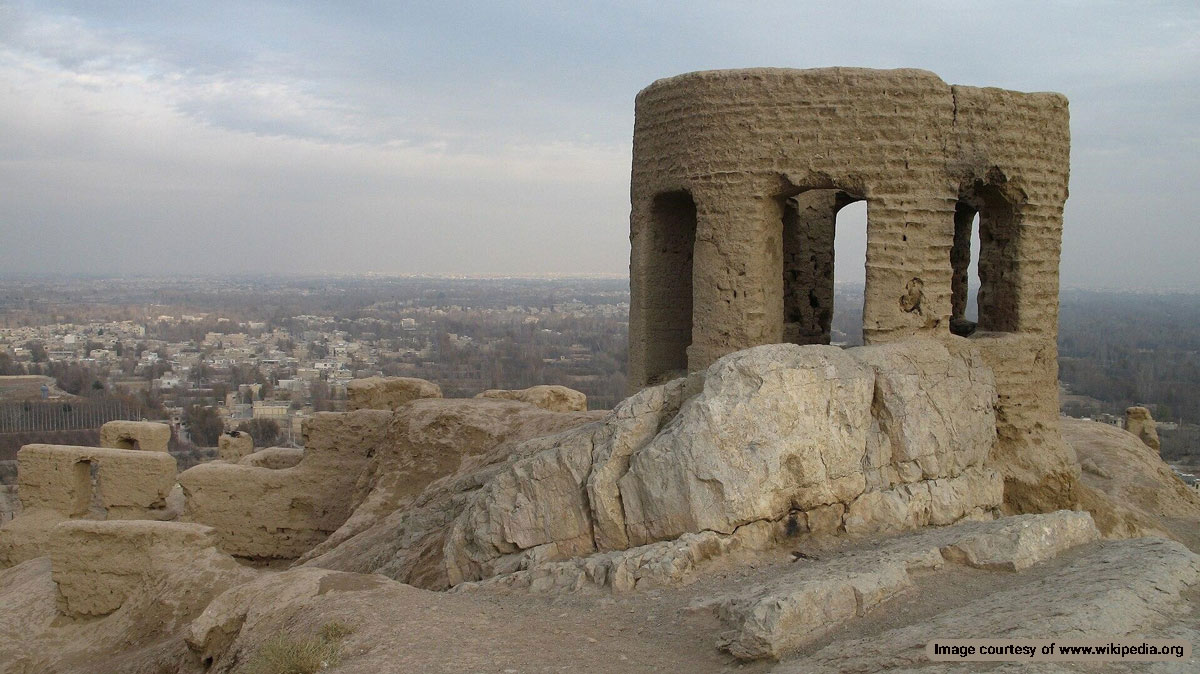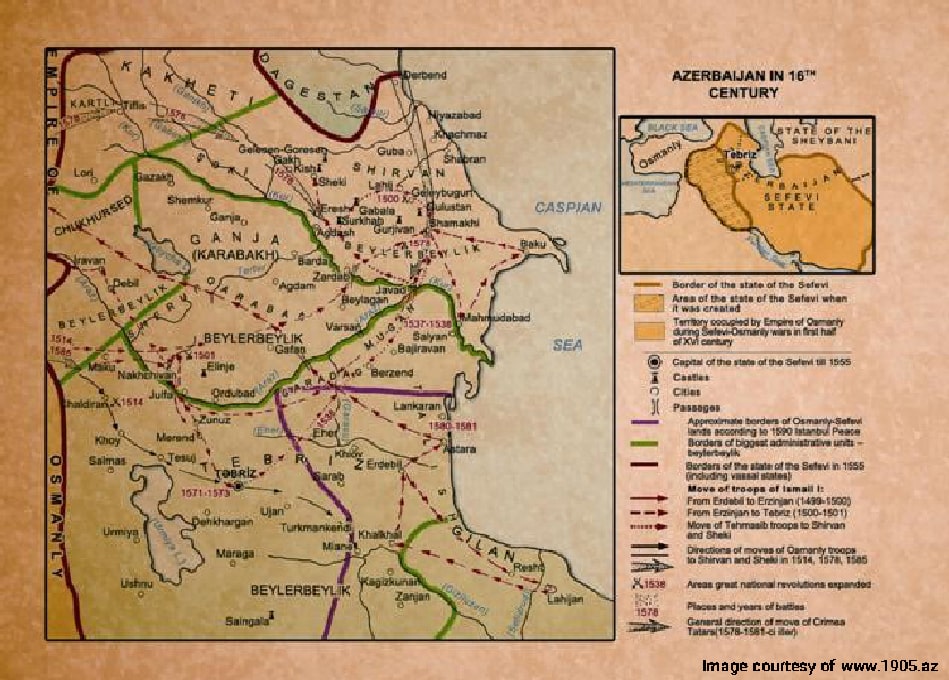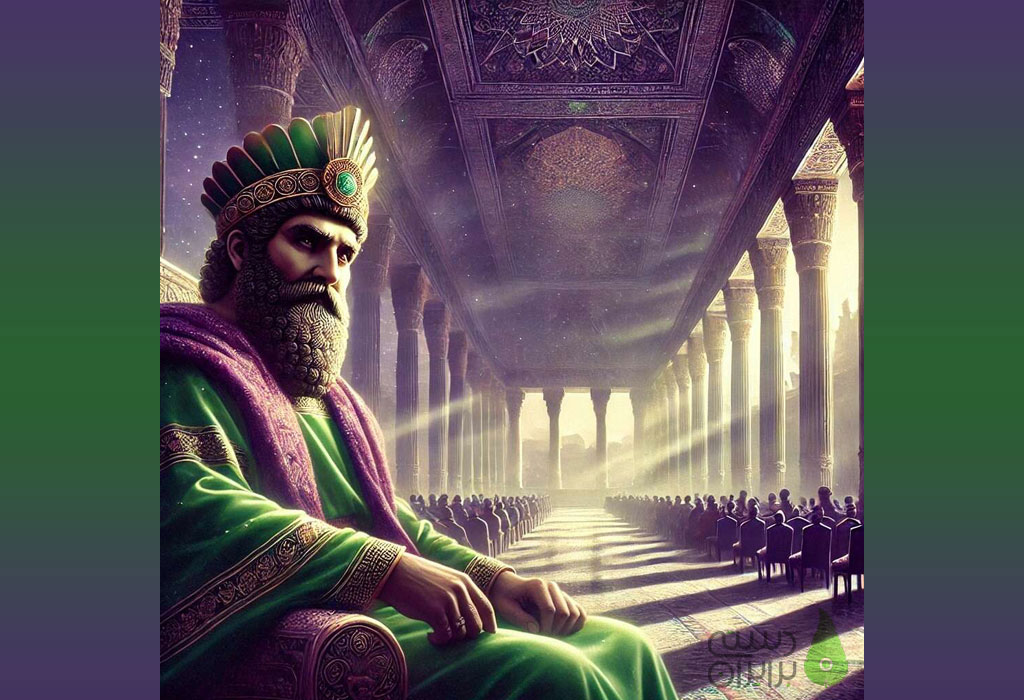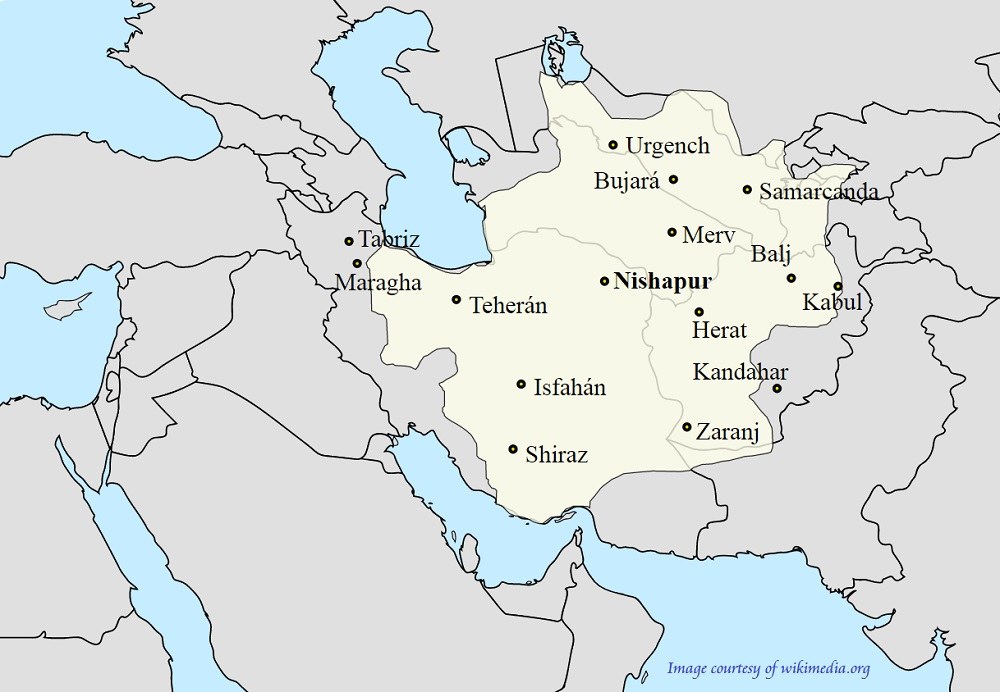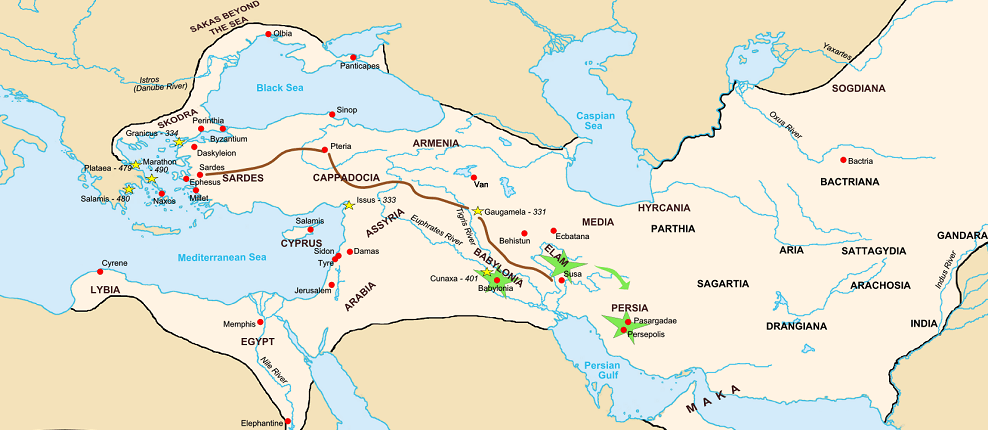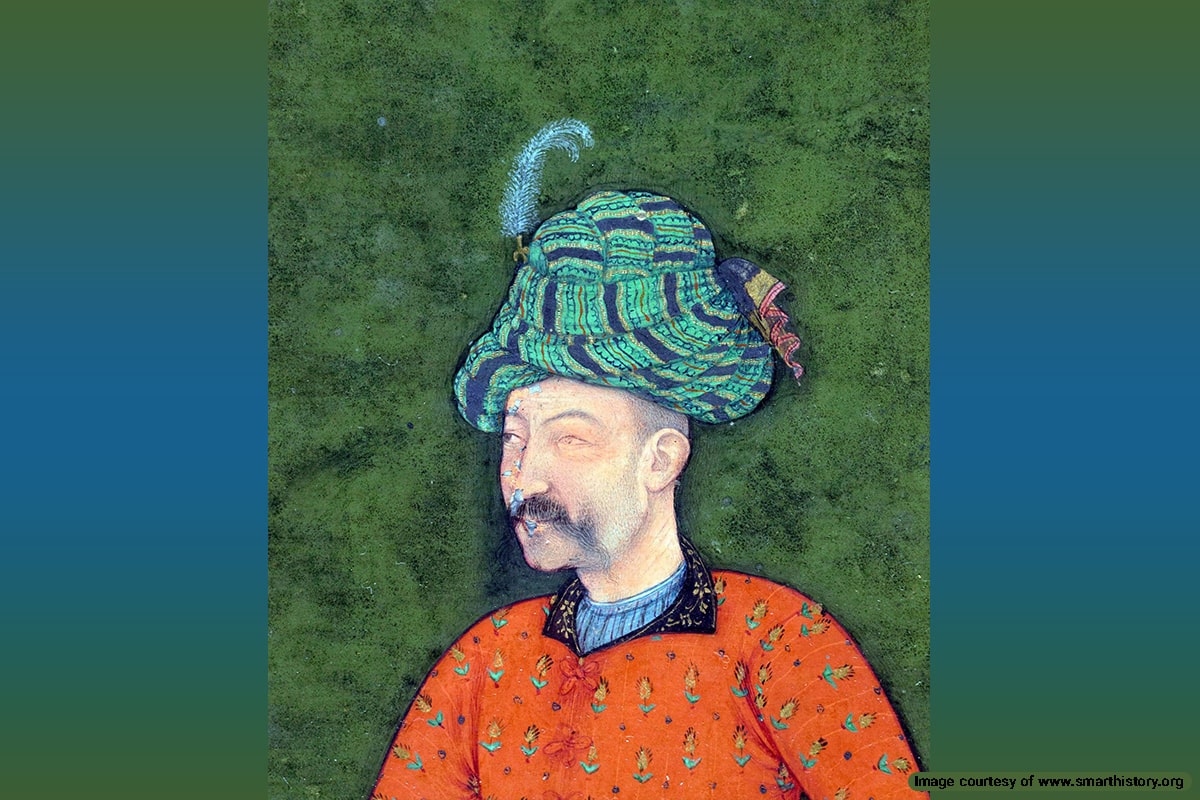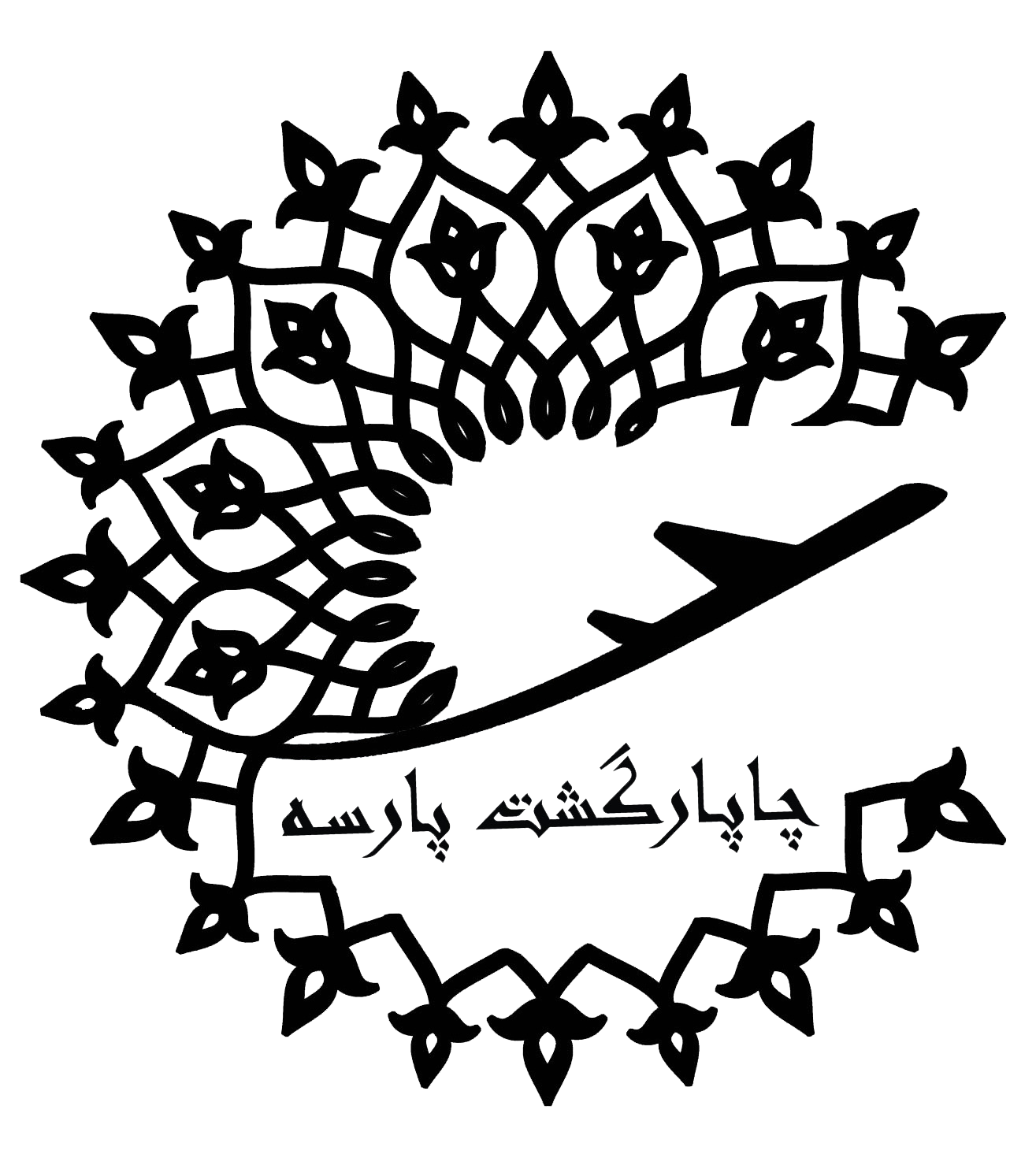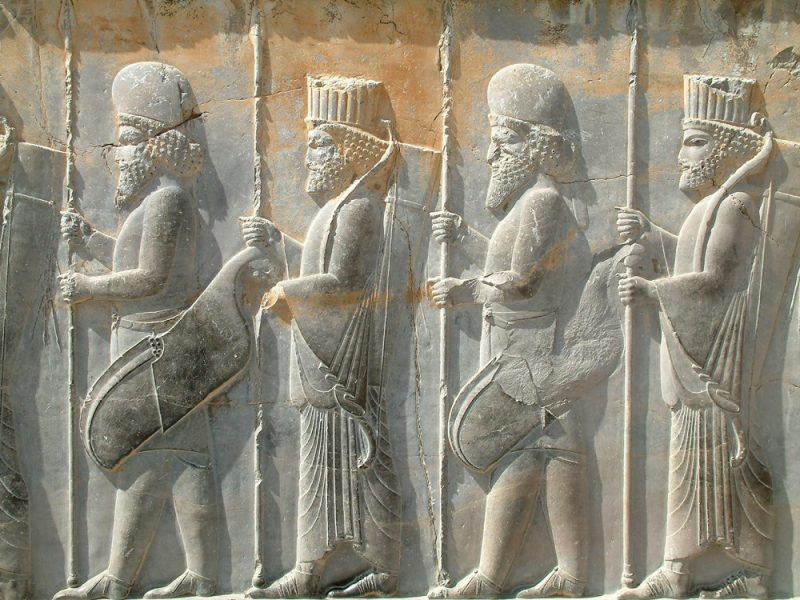
Iranian history is a long and complex story of invasions, resistance, reconstructions, and the perseverance of an ancient nation. The history of Iran has witnessed glorious empires and their downfalls. Iran’s rich culture and civilization have been the cause of its survival despite all the ups and downs.
Destination Iran presents Iran’s history chronologically to help readers remember the many dynasties and provide easy access to a summary.
Summary Table of Iranian History
Here is a brief table indicating the history of Iran at a glance:
| Row | Dynasty | Start | End |
| 1 | Elam | 2700 BC | 2539 BC |
| 2 | Medes | 549 BC | 607 BC |
| 3 | Achaemenid | 330 BC | 550 BC |
| 4 | Seleucid | 247 BC | 330 BC |
| 5 | Parthian | 224 BC | 247 AD |
| 6 | Sassanid | 224 AD | 642 AD |
| 7 | Arab Rule | 642 | 821 |
| 8 | Tahirid | 821 | 893 |
| 9 | Alid | 828 | Gradual Collapse |
| 10 | Saffarid | 867 | 892 |
| 11 | Samanid | 892 | 1005 |
| 12 | Zyarid, Buyid and Daylamites | 928 | 1052 |
| 13 | Ghaznavids | 962 | 1040 |
| 14 | Seljuk | 1040 | 1194 |
| 15 | Khwarazmian or Anushtegin | 1194 | 1231 |
| 16 | Ilkhanid | 1256 | 1383 |
| 17 | Timurid | 1383 | 1501 |
| 18 | Safavid | 1501 | 1736 |
| 19 | Afsharid | 1736 | 1795 |
| 20 | Zand | 1751 | 1794 |
| 21 | Qajar | 1795 | 1925 |
| 22 | Pahlavi | 1925 | 1979 |
Prehistoric Iran History Timeline
The Paleolithic Period in Iranian History (1,000,000 – 13,000 Years Ago)
The Paleolithic era in Iran started around one million years ago. It marks the use of stone in crafting tools. The tools from this period are rudimentary, but we see a focus on stone blades in the Middle Paleolithic period. This era is divided into four periods:
Lower Paleolithic Period (1,000,000 – 200,000 years ago)
Evidence of human settlements from this period is found in various sites in the north, northeast, and northwest of modern-day Iran in the Kashafrud Basin near Mashhad, Ganj Par site and Darband Caves in Gilan, and Shiwatoo site in West Azerbaijan province. The hominin species in this era included the Homo erectus and the Homo ergaster.
Middle Paleolithic Period (200,000 – 40,000 years ago)
Most evidence from this period has been discovered along the Zagros Mountain range. During the Middle Paleolithic era, the Neanderthals from the Mousterian culture roamed central Iran. Archeological sites from this period include the Tamtameh Cave near Lake Urmia in West Azerbaijan province and several caves in Lorestan, Gorgan, Kermanshah, and Isfahan provinces.
Upper Paleolithic (37,000 – 13,000 years ago)
The evolution of stone tools in the Upper Paleolithic in Iran was observed in archeological sites in Kermanshah, Lorestan, Shiraz, and Kashan.
Epipaleolithic Period in Iranian History
This period bridges the gap between the Paleolithic and Neolithic eras in the history of Iran. It lasted from 20,000 to 13,000 years ago. During this period, hunter-gatherer and fisher groups inhabited the caves of the Zagros region and across modern-day Kermanshah, Lorestan, Shiraz, and Kashan.
Iran History Timeline of Prehistoric Cultures
| Culture/Archaeological Site | Location | Estimated Time of Origin (BCE) |
| Kashafrud Culture | Kashafrud | 100,000 – 30,000 years ago |
| Ganj Dareh Culture | Kermanshah | 11,000 – 10,000 years ago |
| Yafteh Cave Culture | Zagros Mountains | 40,000 – 30,000 years ago |
| Bisitun Cave Culture | Kermanshah | 40,000 – 10,000 years ago |
| Wezmeh Cave Culture | Kermanshah | 40,000 – 10,000 years ago |
| Warwasi Culture | Kermanshah | 40,000 – 10,000 years ago |
| M’lefaat Culture | Kermanshah | 35,000 – 12,000 years ago |
| Belt Cave Culture | Kermanshah | 35,000 – 12,000 years ago |
| Darband Culture | Kermanshah | 35,000 – 12,000 years ago |
| Kobeh Culture | Kermanshah | 35,000 – 12,000 years ago |
| Ourmiah Culture | Kermanshah | 35,000 – 12,000 years ago |
| Barda Balka Culture | Kermanshah | 35,000 – 12,000 years ago |
| Kelar Culture | Lorestan | 40,000 – 10,000 years ago |
| Rostamabad Culture | Lorestan | 30,000 – 10,000 years ago |
| Balarud Culture | Shiraz | 30,000 – 10,000 years ago |
| Tepe Sialk Culture | Kashan | 10,000 – 9,000 years ago |
| Zarzian Culture West | Azerbaijan | 18,000 – 8,000 years ago |
| Tureng Tepe Culture | Gorgan | 12,000 – 8,000 years ago |
| Qaleh Bozi Culture | Isfahan | 11,000 – 9,000 years ago |
Iran History: Neolithic Period (10,000 – 8,000 Years Ago)
Significant changes occurred in human civilization around 10,000 years ago during the Neolithic era. Humans transitioned from hunting and gathering to settled life. Agriculture was developed, and communities cultivated crops and domesticated animals. While early cultures were present, the civilizations of this era cannot be considered a meaningful origin of Iran history.
| Culture/Archaeological Site | Location | Estimated Time of Origin (BCE) |
| Chogha Bonut Culture | Khuzestan | 7,000 – 6,200 years ago |
| Chogha Mish Culture | Khuzestan | 6,200 – 5,200 years ago |
| Jarmo Culture | Kurdistan | 7,000 – 6,000 years ago |
| Zagheh Culture | Kurdistan | 6,300 – 5,850 years ago |
| Tajrish Culture | Tehran | 7,000 – 6,500 years ago |
| Cheshmeh-Ali Culture | Tehran | 7,000 – 6,500 years ago |
| Sarab Culture | Tehran | 8,000 – 6,800 years ago |
| Ganj Dareh Culture | Kermanshah | 10,000 – 8,000 years ago |
| Ali Kosh Culture | Kermanshah | 9,000 – 7,500 years ago |
| Chia Jani Culture | Lorestan | 7,500 – 6,200 years ago |
| Tepe Asiab Culture | Lorestan | 6,000 – 5,000 years ago |
| Konar Sandal: A Culture | Lorestan | 6,000 – 5,000 years ago |
| Rudbar Culture | Shiraz | 7,500 – 6,000 years ago |
| Tape Sialk Culture | Kashan | 7,500 – 6,500 years ago |
| Chogha Golan Culture | West Azerbaijan | 8,000 – 6,500 years ago |
| Yarim Tepe Culture | Gorgan | 8,000 – 6,500 years ago |
| Hasanlu Culture West | Azerbaijan | 6,500 – 5,800 years ago |
| Kabudan Tepe Culture | Isfahan | 7,000 – 6,000 years ago |
Chalcolithic Period (Copper Age) (8,000 – 6,000 Years Ago)
The Chalcolithic period bridges the gap between the Neolithic and Bronze Age in Iran’s history. It’s characterized by the use of both stone and copper tools. Around 5500–3500 BC, communities in Iran developed advanced pottery, traded goods, and engaged in early metallurgy. The number of villages increased during this period, and cities grew in size as well.
| Culture/Archaeological Site | Location | Estimated Time of Origin (BCE) |
| Sialk Culture | Kashan | 5,500 – 4,200 years ago |
| Hajji Firuz Tepe Culture | Hamadan | 5,500 – 4,200 years ago |
| Tal-i Iblis Culture | Khuzestan | 5,000 – 4,500 years ago |
| Tal-i Bakun Culture | Khuzestan | 5,000 – 4,500 years ago |
| Siah Dareh Culture | Kermanshah | 5,000 – 4,200 years ago |
| Tepe Siahku Culture | Lorestan | 5,000 – 4,200 years ago |
| Tepe Yahya Culture | Lorestan | 5,000 – 4,200 years ago |
| Tall-e Bakun A Culture | Lorestan | 5,000 – 4,500 years ago |
| Hajji Firuz Tepe Culture | Lorestan | 5,100 – 4,100 years ago |
| Qaleh Kandi Culture | Lorestan | 5,000 – 4,300 years ago |
| Anau Culture | East Azerbaijan | 5,000 – 4,500 years ago |
| Tal-i Malyan Culture | Fars | 5,500 – 4,200 years ago |
| Cheshmeh Ali Culture | Fars | 5,500 – 4,200 years ago |
| Godin Tepe Culture | Kerman | 5,500 – 4,200 years ago |
| Zanbil Tepe Culture | Kerman | 5,500 – 4,200 years ago |
| Tal-i Malyan Culture | Kerman | 5,500 – 4,200 years ago |
Bronze Age Origin of Iran, Indo-Aryan Migration, Medes Empire (5,400 – 3,400 Years Ago)
Large cities emerged, trade networks expanded, and civilizations invented monumental architecture. This era ushered in a remarkable age of prosperity for civilizations on the Iranian Plateau. During this period, the Indo-Aryan tribes slowly migrated to the plateau. In addition, the Medes rose to power but left no records of their history.
| Culture Archaeological Site | Location | Estimated Time of Origin (BCE) |
| Marlik Culture | Gilan | 3,300 – 2,200 years ago |
| Jiroft Culture | Kerman | 3,300 – 2,200 years ago |
| Shahr-i Sokhta Culture | Sistan and Baluchestan | 4,200 – 3,400 years ago |
| Shah Tepe Culture | Fars | 3,300 – 2,200 years ago |
| Hissar Culture | Fars | 3,300 – 2,200 years ago |
| Zavkhan Culture | Khuzestan | 3,300 – 2,200 years ago |
| Arisman Culture | Lorestan | 3,500 – 2,200 years ago |
| Bani Surmah Culture | Lorestan | 3,300 – 2,200 years ago |
| Yahya Culture | Lorestan | 3,000 – 2,400 years ago |
| Bampur Culture | Sistan and Baluchestan | 3,300 – 2,200 years ago |
| Mangul Tepe Culture | Sistan and Baluchestan | 3,300 – 2,200 years ago |
| Jazirah Culture | Kerman | 3,500 – 2,500 years ago |
| Kulli Culture | Kerman | 3,500 – 2,500 years ago |
| Konar Sandal B Culture | Lorestan | 3,300 – 2,200 years ago |
| Keban Culture | Lorestan | 3,300 – 2,200 years ago |
| Dalma Culture | Khuzestan | 3,500 – 2,500 years ago |
| Culture Archaeological Site | Location | Estimated Time of Origin (BCE) |
| Luristan Bronzes Culture | Lorestan | 1,300 – 650 years ago |
| Hasanlu Culture | Azerbaijan | 1,250 – 700 years ago |
| Kurangun Culture | Kerman | 1,250 – 700 years ago |
| Tepe Hissar Culture | Fars | 1,200 – 700 years ago |
| Marlik Culture | Gilan | 1,200 – 700 years ago |
| Izeh Culture | Khuzestan | 1,200 – 700 years ago |
| Kangavar Culture | Kermanshah | 1,200 – 700 years ago |
| Meshgin Shahr Culture | Ardabil | 1,200 – 700 years ago |
| Kermanshah Culture | Kermanshah | 1,200 – 700 years ago |
| Sagzabad Culture | Fars | 1,200 – 700 years ago |
| Khorvin Culture | Gorgan | 1,200 – 700 years ago |
| Sialk Culture | Isfahan | 1,150 – 650 years ago |
| Shahdad Culture | Kerman | 1,150 – 500 years ago |
| Tappeh Sialk | Isfahan | 1,200 – 650 years ago |
| Haft Tepe | Fars | 1,100 – 700 years ago |
Historical Period
Iranian History in 1500–550 BCE, the Iron Age of Iran
The Iron Age of Iran (c. 1500–550 BCE) marked a transformative period in the region’s history, characterized by the widespread use of iron tools and weapons, the rise of powerful kingdoms, and significant cultural and technological advancements.
This era saw the emergence of influential civilizations such as the Medes, Persians, and Mannaeans, who laid the groundwork for the later Achaemenid Empire. The Iron Age was a time of increased urbanization, trade, and interaction with neighboring regions, shaping ancient Iran’s cultural and political landscape.
Iran History Before Islam
2700–539 BCE, the Elamite Civilization
The Elam culture marks the establishment of the first full-fledged civilization in the Iranian plateau. Their achievements included building advanced cities such as Susa, a proper political system, establishing trade with other cultures, and innovations in craftsmanship.
Chronology of the Elamite Civilization:
- c. 2700 BCE
The Elamite civilization emerged, with its capital at Susa, one of the oldest cities in the world.
- c. 2300 BCE
Elam came under the influence of the Akkadian Empire but retained its cultural and political identity.
- c. 2000 BCE
The Elamites established a powerful kingdom, often engaging in conflicts and alliances with Mesopotamian states like Babylon and Assyria.
- c. 1500–1100 BCE
The Middle Elamite period marked a golden age, with rulers like Untash-Napirisha constructing monumental structures such as the ziggurat of Chogha Zanbil.
- c. 646 BCE
The Assyrian king Ashurbanipal launched a devastating campaign against Elam, sacking Susa and weakening the civilization.
- 539 BCE
Elam was absorbed into the Achaemenid Empire under Cyrus the Great, marking the end of its political independence.
607–549 BCE, the Medes Empire
The Medes were an ancient Iranian people who established one of the earliest Iranian empires, the Medes Empire, in the first millennium BCE. Located in the northwestern region of modern-day Iran, the Medes played a crucial role in the history of the ancient Near East, particularly in the downfall of the Assyrian Empire and the rise of the Achaemenid Persian Empire.
Chronology of the Medes Empire:
- c. 1100 BCE
Medes migrated to the Iranian Plateau.
- c. 728 BCE
Deioces united Median tribes and established Ecbatana.
- c. 675–653 BCE
Phraortes expanded Median power and died fighting Assyrians.
- c. 653–625 BCE
Assyrian and Scythian dominance over Media.
- c. 625–585 BCE
Cyaxares reorganized the army, allied with Babylon, and destroyed Assyria (612 BCE).
- 585 BCE
Battle of the Eclipse with Lydia; Cyaxares dies, Astyages succeeds.
- 550 BCE
Cyrus the Great overthrows Astyages, founding the Achaemenid Empire.
550–330 BCE, the Achaemenid Empire
Historical documents from this period were classified for 200 years.
After the war left Elam in ruins, Cyrus the Great marched through Anshan. He took control of Elam around 558 BC, which most consider the origin of Iran as a nation. This event ushers in an era of great empires in Iran history before Islam. He established the postal service, the first human rights charter, and the diversity of religions in his territories. Darius was another key figure in Achaemenid history who expanded their territory. Alexander the Great’s conquest ended this proud chapter in Iranian history.
Chronology of the Achaemenids:
- 550 BCE
Cyrus the Great defeated the Medes at Pasargadae and founded the Achaemenid Empire, marking the beginning of the Persian Empire’s expansion.
- 522 to 486 BCE
Darius I, also known as Darius the Great, suppressed rebellions, established the first civil administration in Iran and further expanded the empire. He ordered the construction of Persepolis, which symbolized the empire’s grandeur.
- 330 BCE
Alexander the Great invaded Persia, destroyed the partially completed Persepolis, and took control of the Persian Empire, marking the end of Achaemenid rule.
- 323 BCE
Alexander the Great’s death fragmented his empire and led to the rise of the Seleucid Empire in Persia.
312–63 BCE, the Seleucid Empire
The Seleucid Empire was one of the successor states of Alexander the Great’s vast empire, established by Seleucus I Nicator. Spanning from the eastern Mediterranean to Central Asia, it was one of the largest Hellenistic kingdoms.
The empire was crucial in spreading Greek culture and blending it with local traditions, particularly in Persia and Mesopotamia. Despite its size and influence, the Seleucid Empire faced constant challenges, including internal strife, external invasions, and the rise of regional powers like the Parthians and Romans.
Chronology of the Seleucids:
- 312 BCE
Seleucus I Nicator founded the Seleucid Empire after the division of Alexander the Great’s empire. Its capital was Seleucia on the Tigris.
- 305–281 BCE
Seleucus I expanded the empire to include much of the Near East, Persia, and Central Asia, making it one of the largest Hellenistic states.
- 3rd century BCE
The empire faced challenges from the Mauryan Empire in the east and the Ptolemaic Kingdom in the west, leading to territorial losses.
- 190 BCE
The Battle of Magnesia, where the Romans defeated the Seleucids, marked the beginning of the empire’s decline and loss of influence in Asia Minor.
- 2nd–1st centuries BCE
The rise of the Parthian Empire in Persia and the growing power of Rome further weakened the Seleucids, reducing their territory to a small region in Syria.
- 63 BCE
The Roman Republic annexed the Seleucid Empire under Pompey the Great, marking its official end.
247 BCE–224 CE, The Parthian Empire
The Parthian Empire was a major Iranian empire that rose to power after overthrowing the Seleucid Empire. Known for its skilled cavalry, decentralized governance, and role as a bridge between East and West, the Parthians ruled over a vast territory stretching from the Euphrates River to the Indus River.
The empire is celebrated for its resilience against Roman expansion, cultural syncretism, and its role in reviving Persian traditions after the Hellenistic period. The Parthian era laid the groundwork for the later Sassanid Empire.
Chronology of the Parthians:
- 247 BCE
Arsaces I founded the Parthian Empire by revolting against the Seleucid Empire and establishing the Arsacid dynasty.
- 141 BCE
Mithridates I expanded the empire, capturing Mesopotamia and parts of Iran, and declared himself Shahanshah (King of Kings).
- 53 BCE
The Battle of Carrhae, where the Parthian general Surena decisively defeated the Roman general Crassus, marking one of Rome’s most humiliating defeats.
- 1st century CE
The Parthian Empire became a significant power in the ancient world, frequently clashing with the Roman Empire over control of Armenia and Mesopotamia.
- 58–63 CE
The Roman-Parthian War over Armenia culminated in the Treaty of Rhandeia, which established a Parthian prince as the ruler of Armenia under Roman suzerainty.
- 2nd century CE
The Parthian Empire faced internal strife and external pressures, including Roman invasions under emperors Trajan and Septimius Severus.
- 224 CE
The last Parthian king, Artabanus IV, was defeated by Ardashir I at the Battle of Hormozdgan. This led to the Parthian Empire’s fall and the Sassanid Empire’s rise.
224–651 CE, the Sassanid Empire
The Sassanid Empire, founded by Ardashir I, was one of the most influential Persian empires. After the fall of the Parthian Empire, it marked the revival of Persian culture, art, and governance. The Sassanid Empire became a significant world power, rivaling the Roman and later Byzantine Empires.
The empire is renowned for its centralized administration, Zoroastrian religious influence, and monumental architecture. Its legacy endured long after it fell to the Arab Muslim conquests in the mid-7th century.
Chronology of the Sassanid Empire:
- 224 CE
Ardashir I defeated the last Parthian king, Artabanus IV, at the Battle of Hormozdgan, establishing the Sassanid Empire and declaring himself Shahanshah (King of Kings).
- 240–270 CE
Reign of Shapur I, Ardashir’s son, who expanded the empire, defeated Roman emperors Gordian III and Philip the Arab and captured Emperor Valerian at the Battle of Edessa (260 CE).
- 3rd–4th centuries CE
The Sassanid Empire became a center of Zoroastrianism, with the religion being institutionalized and promoted as the state religion.
- 309–379 CE
Reign of Shapur II, one of the longest-reigning monarchs in history. He strengthened the empire, defended against Roman and nomadic incursions, and promoted Zoroastrian orthodoxy.
- 5th century CE
The empire faced challenges from the Hephthalites (White Huns) in the east, leading to significant conflicts and territorial losses.
- 531–579 CE
Reign of Khosrow I (Anushirvan), considered the empire’s golden age. He implemented significant administrative reforms, promoted science and philosophy, and established the famous academy of Gondishapur.
- 602–628 CE
The Byzantine-Sassanid War, a prolonged conflict with the Byzantine Empire, weakened both powers and left them vulnerable to external threats.
- 651 CE
The Sassanid Empire fell to the Arab Muslim conquests after the Battle of Nahavand, marking the end of pre-Islamic Persian empires and the beginning of Islamic rule in Persia.
The History of Iran after Islam
Public discontent with the Sassanids’ authority gave the Arab invaders ample opportunity to attack and conquer Iran. After the collapse of the Sassanid kingdom and the Arab conquest of Persia, a new chapter opened in the story of Iran, fundamentally reshaping the country’s fate compared to Iran history before Islam.
After the Arab invasion of Iran, Iranians experienced three periods of Arab rule: the Rashidun Caliphate, the Umayyad Dynasty, and the Abbasid Caliphate. All of these periods saw unrest and rebellion from Iranians against Arab rule. Since the Abbasid caliphate, Iranians gradually established semi-independent local governments, leading to the decline of the Caliphate’s rule over Iran and creating the governmental origin of Iran after Islamic rule.
The following is the Iranian History after the Arab Invasion of Iran:
- 661 to 750 AD The rule of the Umayyad Caliphate in Damascus.
- 750 to 1257 AD The rule of the Abbasid Caliphate in Baghdad.
- 756 to 1031 AD Arab Caliphate of Córdoba.
- 872 to 903 AD The establishment of the Saffarid dynasty in Khorasan.
- 903 to 999 AD The rise of the Samanid dynasty in Khorasan.
- 935 to 1055 AD The rise of the Buyid dynasty near Shiraz.
- 962 to 1044 AD The emergence of the Ghaznavids dynasty in the east and challenge to Samanid authority.
1040 – 1194, the Seljuk Timeline
From 1037 until 1055 AD, the Seljuk Turks attacked Iran, led by Tughril I. Abu Muslim Abd al-Rahman ibn Muslim al-Khurasani, the Iranian commander of the Abbasid Revolution, ended the Buyid dynasty.
Chronology of the Seljuk Period:
- Early Origins and Rise to Power – 10th–11th centuries
- Conquest of Khorasan – 1037
- Battle of Dandanqan (Defeat of the Ghaznavids) – 1040
- Tughril Beg Declares Sultanate – 1037–1063
- Battle of Manzikert (Victory over Byzantines) – 1071
- Reign of Malik Shah I and Nizam al-Mulk – 1072–1092
- Fragmentation of the Empire – 1092 onwards
- Rise of Regional Atabegs and Seljuk Branches – 12th century
- Defeat by the Khwarezmians – 1194
1172 – 1220 Khwarezmians
Chronology of the Khwarezmians:
- 1077
Rise of the Khwarezmian Dynasty
- 1141
Independence from the Seljuks
- 1172–1200
Expansion under Ala ad-Din Tekish
- 1200–1220
Reign of Muhammad II and Peak of Power
- 1220–1231
Mongol Invasion and Fall of the Khwarezmian Empire
1256 – 1383 Ilkhanid (Mongol) Dynasty
The Ilkhanate was a Mongol khanate established in Persia and the broader Middle East by Hulagu Khan, a grandson of Genghis Khan, in the mid-13th century. As one of the four divisions of the Mongol Empire, the Ilkhanate played a crucial role in shaping the region’s history after the Mongol conquests.
Chronology of the Ilkhanate:
- 1256
Establishment of the Ilkhanate by Hulagu Khan
- 1258
Sack of Baghdad (End of the Abbasid Caliphate)
- 1295–1304
Reign of Ghazan Khan and Conversion to Islam
- 1335
Decline and Fragmentation of the Ilkhanate
1383 – 1501, the Timurid Dynasty
Chronology of the Timurid Dynasty:
- From 1380 AD to 1393 AD, Timur conquered Iran. The Church of the East was closed.
- From 1397 to 1447 AD, Timur destroyed India and died shortly after. His successor, Shahrukh Mirza, conquered the “Amu Darya” region.
- 1408 AD to 1453 AD Rise of Qara Qoyunlu Turkmen.
- 1461 AD The Ottoman Turks invaded the northwest of Iran and pushed the Timurids back to the east.
1501 – 1736, the Safavid Dynasty
The Safavids established a powerful central government in Iran. Shah Ismail founded this dynasty, which Shah Abbas led to its peak of power and stability. In this chapter of Iran’s story, figures such as Shah Suleyman, his son Soltan Hoseyn, and other Safavid kings were in power.
During the Safavid era, Iran was in constant conflict with the Ottoman Empire, its neighbor to the east.
Chronology of the Safavid Era:
- From 1502 to 1524 AD Shah Ismail I founded the Safavid dynasty. For the first time in Iran’s history, Shia Islam was declared the country’s official religion.
- From 1587 to 1628 AD Shah Abbas I defeated the Ottomans in the north, conquered Baghdad, and selected Isfahan as the capital.
- 1624 AD to 1722 AD: The Afghan Siege of Isfahan led to the ransacking of the kingdom, dethroning the Safavid dynasty. At this time, Soltan Hoseyn was the king. After him, Shah Tahmasab II and Shah Abbas III tried to seize power in some regions of Iran but were unsuccessful.
- 1722 AD to 1724 AD: The Afghan army conquered Iran and pillaged Isfahan and Shiraz. They massacred the Safavid princes.
1736 – 1796, the Afsharid Dynasty
Nader Qoli was a war general who freed Isfahan from the Afghan invaders and delivered it to the Safavid king, Shah Tahmasab II. Shah Tahmasp was defeated in the battle with the Ottomans and signed a peace treaty with the Ottoman Empire. Nader Qoli Khan realized the Safavid incompetence and decided to take matters into his own hands.
With the support of Iranian elders, Nader Khan was crowned Nader Shah and founded the Afsharid dynasty. After Nader Shah Afshar, the Afshar dynasty did not have a powerful king and was replaced by the Zand dynasty.
Chronology of the Afsharid Dynasty:
- 1736
Nader Shah crowned himself Shah after deposing the last Safavid ruler and establishing the Afsharid Dynasty.
- 1737–1739
Nader Shah launched a series of military campaigns, including the invasion of India, where he decisively defeated the Mughal Empire at the Battle of Karnal (1739) and looted the legendary Peacock Throne and Koh-i-Noor diamond.
- 1740s
Nader Shah expanded the empire into Central Asia, conquering regions such as Bukhara and Khiva, and campaigned against the Ottomans in the west.
- 1747
Nader Shah was assassinated by his own officers, leading to the fragmentation of the empire and the rise of regional powers.
- 1747–1796
The Afsharid Dynasty continued in a diminished form, with Nader Shah’s descendants ruling parts of Khorasan until the rise of the Qajar Dynasty.
1751-1794, the Zandieh Dynasty
The Zand Dynasty was a Persian dynasty that emerged iafterthe fall of the Safavid Empire and the chaos of Nader Shah’s reign. Founded by Karim Khan Zand, the dynasty is remembered as a period of relative peace, prosperity, and cultural revival in Persia.
Unlike many rulers before him, Karim Khan refused to take the title of Shah, instead calling himself Vakil-e Ra’ayat (Advocate of the People). The Zand Dynasty is notable for its emphasis on justice, infrastructure development, and the flourishing of arts and architecture, particularly in its capital, Shiraz.
Chronology of the Zands:
1751
Karim Khan Zand consolidated power after years of civil war and tribal disputes, establishing the Zand Dynasty and making Shiraz the capital.
1760s–1770s
Karim Khan focused on rebuilding Persia’s economy and infrastructure, promoting trade, agriculture, and urban development.
1779
The death of Karim Khan Zand led to a power struggle among his successors and the eventual decline of the dynasty.
1781–1785
Lotf Ali Khan, the last Zand ruler, fought valiantly to preserve the dynasty but was ultimately defeated by Agha Mohammad Khan Qajar.
1794
The Zand Dynasty officially ended with the execution of Lotf Ali Khan by Agha Mohammad Khan Qajar, marking the rise of the Qajar Dynasty.
1795 – 1925, the Qajar Dynasty
The Qajar dynasty ruled Iran for 130 years. During their reign, important regions of the country were lost to foreign interests, and the country experienced a rather eventful period, including the 1921 Persian coup d’état and the rise of Reza Shah, founder of the Pahlavi dynasty.
Chronology of the Qajar Dynasty:
- 1795 AD to 1925 AD The Qajar dynasty was a local authority ruled in Tehran.
- 1796 AD Agha Mohammad Khan Qajar founded the Qajar dynasty.
- 1818 AD During the reign of Fath-Ali Shah Qajar, the Treaty of Gulistan was finalized between Iran and Russia, which saw lands from the north of Iran surrendered to Russia.
- 1827 AD Russian Occupation of Tabriz.
- In 1828 AD, Fath-Ali Shah Qajar and the Tsarist government of Russia signed the Treaty of Turkmenchay, concluding the Russia-Iran war. According to this agreement, Yerevan, Nakhichevan, and the remainder of the Talysh Khanate surrendered to Russia.
- 1896 to 1906 AD, the Persian Constitutional Revolution took place.
- 1906 AD: With the establishment of the Persian Parliament, constitutionalism was officially adopted as a system of government.
- 1908 AD Rise of Iranian Nationalist Movement.
- 1909 AD The Anglo-Persian Oil Company was founded; This company was later called British Petroleum.
- From 1917 to 1919 AD, the Persian famine occurred in Iran during the First World War. 40% of the country’s population perished in this famine.
- 1920 AD The uprising of Shaikh Mohammad Khiābāni in Tabriz and Mirza Kuchik Khan in Gilan.
- From 1909 to 1923 AD, Ahmad Shah was the last Qajar king. Reza Khan was appointed Prime Minister.
- 1922 AD The 1921 Persian coup d’état by Reza Khan and the removal of Ahmad Shah, the last Qajar king. The Qajar dynasty collapsed in 1924.
1925 – 1979, the Pahlavi Dynasty
With the collapse of the Qajar dynasty, the Pahlavi dynasty gained power in Iran. During this period, Iran entered a new era of development and took a step toward modernity. Iran’s history witnessed the country’s modernization for the first time. Reza Shah Pahlavi tried to revive the ancient culture of Iran and the ancient Persian empire. He is known for his dominance and dictatorship in governance.
Chronology of the Pahlavi Dynasty:
- In 1925 AD Reza Khan declared himself “Reza Shah” and founded the Pahlavi dynasty.
- 1314 AD The title of Pars or Persia was selected for Iran and globally announced as the country’s official name.
- 1941 AD During World War II, the Allies occupied Iran. Reza Shah abdicated the throne and went into exile. His son Mohammad Reza replaced him as the next Pahlavi king.
- 1943 AD The Tehran Conference hosted Churchill, Roosevelt, and Stalin. Iran regained its territorial integrity.
- In 1951 AD Dr. Mohammad Mosaddegh was elected prime minister and worked towards nationalizing the oil industry.
- 1953 AD The 1953 Iranian coup d’état against the Nationalization of the Iranian oil industry, during which Mohammad Mosaddegh, the prime minister of Iran before the Shah’s fall, was arrested and put on trial. Mohammadreza Shah returned to Iran.
- 1955 AD, Iran joined the Central Treaty Organization.
- 1959 AD, Iran signed a defense pact with the United States.
- 1963 AD Ayatollah Khomeini instigated a religious uprising on a national level and in protest against the Shah.
- 1967 AD In Iran 1967, the Official Coronation of Shah Mohammad Reza Pahlavi and Queen Farah Pahlavi took place, marking the rise of the last Shah of Iran.
- 1969 AD Heightened tensions between Iran and Iraq over the rights to Arvandrud (Shatt Al Arab).
- 1971 AD The 2,500-year celebration of the Persian Empire.
- 1978 to 1979 AD People’s protests against the monarchy increased, and Mohammadreza Shah left Iran, leading to the collapse of the Pahlavi dynasty. The Shah of Iran 1979 escape is considered the official marker of the victory of Iran’s Islamic revolution.
1979 – Present, The Islamic Republic of Iran
The Islamic Revolution of Iran is one of the most controversial events in Iran history timeline. For the first time in Iranian history, the story of Iran supposedly fell into the people’s hands. With the fall of the last Shah of Iran, the country opened a new chapter in the history of Iran.
Chronology of the Islamic Republic of Iran:
- 1979 AD The majority of Iranians voted to establish the government of the Islamic Republic of Iran under the leadership of Ayatollah Khomeini.
- 1980 AD Iraq Invasion of Iran and Iran–Iraq War.
- 1988 AD Iran and Iraq recognized United Nations Security Council Resolution 598 and Iran announced the final ceasefire of the 8-year war.
- 1989 AD Ayatollah Khomeini died, and Ayatollah Khamenei was selected as the Supreme Leader of the Islamic Republic.
Learn More About the History of Iran
- Investigating the rise and fall of the Achaemenids by visiting three historical places
- Iran on the ancient silk road, the old network of trade routes
- History of Khwarazmian; The era of fear and war (1077 to 1231 AD)
- History of Ghaznavids in Iran after Islam (977 to 1186 AD)
- History of Zyarid, Buyid, and Daylamites (928 to 1062 AD)
- History of Samanid in Iran after Islam (819 to 999 AD)
- History of Saffarid in Iran after Islam (861 to 1003 AD)
- History of Alid in Iran after Islam (year 863 to 928 AD)
- The history of Tahirid in Iran after Islam (from 821 to 873 AD)
- The Importance of Cyrus the Great in the History of Iran
- History of Seljuks, Invaders to Iran in the 11th Century (1040 – 1194)
- The Revolutionary Life and Lasting Legacy of Sattar Khan, Iran’s National Hero
- Zandieh Dynasty, an Era of Reform and Peace (1751-1794 CE)
- History of the Afsharids, the Expansion of the Iranian Empire (from 1736 to 1796 AD)
- Social and Economic Development of Azerbaijan in the Safavid Era
Frequently Asked Questions About Iran’s History
If you cannot find the answer to your question about the history of Iran here, comment in the comments section below this post and ask your question. We will answer it as soon as possible.
How old is Iran?
Ancient civilizations in Iran have existed on the Iranian Plateau for 5,000 years. However, some attribute the history of Iran to the establishment of centralized governments and the beginning of the Achaemenid Empire in 550 BCE. Nevertheless, Iran’s history predates that period, as it was home to civilization and governance during the era of the Elamites.
What are the major prehistoric civilizations of Iran?
In the history of Iran, there have been various ancient civilizations, some of which were independent states and some semi-autonomous. The most important of these civilizations are:
- Shahr-e Sukhteh Ancient Civilization (burnt city) in Sistan
- Shahdad Kalouts in Kerman
- Tepe Sialk in Kashan
- Marlik Hill civilization in Gilan
- Jiroft Culture in Kerman
- Elam civilization in Khuzestan
- Teppe Hasanlu civilization in Azerbaijan
What happened to the Shah of Iran?
Mohammad Reza Pahlavi, the last Shah of Iran, was overthrown during the 1979 Islamic Iran Revolution. He fled to Egypt and died in exile in 1980.
When did Persia become Iran?
The international name change from Persia to Iran was formalized in 1935 under Reza Shah Pahlavi. “Iran” reflects the country’s ancient roots (Land of the Aryans). However, the name dates back to before the Achaemenid era.
What was the ancient name for Iran?
The ancient name of Iran among Greek historians was Pars or Persia. The word is also mentioned in ancient Avesta texts. The name became popular in the first Pahlavi period.
Who was in power before the Shah of Iran?
Before Mohammad Reza Pahlavi, his father, Reza Shah Pahlav, ruled Iran from 1925 until his forced abdication in 1941.
What role have Iranians played in the development of human civilization?
Iranians have played an important role in the evolution of ancient civilizations worldwide. They have been practicing Sedentism since the 6th millennium BC.
When was the Islamic Revolution of Iran?
The Iran Revolution, which occurred in 1979, overthrew the monarchy and established the Islamic Republic.
What was Iran before the Islamic Revolution?
Iran before 1979 was a monarchy under the Pahlavi dynasty, modernizing rapidly but criticized for authoritarianism and Western influence.
Was Iran ever colonized?
Throughout Iran’s history, the country was never fully colonized but faced foreign influence (e.g., British and Russian control in the 19th–20th centuries).
How did the Shah of Iran die?
Mohammad Reza Pahlavi died of cancer in Cairo, Egypt, on July 27, 1980, after fleeing Iran following Iran’s Islamic revolution.
Who ruled Iran before the 1979 revolution?
The Pahlavi dynasty (Reza Shah and Mohammad Reza Shah) ruled Iran from 1925 until the 1979 Iran revolution, marking the first modernization efforts in Iranian history.
Was Iran Ever Communist?
No, Iran has never been a communist state. However, communist movements (e.g., the Tudeh Party) were active in the 20th century, particularly in Iran before 1979. These groups opposed the monarchy but lost influence after the 1979 Islamic Revolution of Iran.
What was the white revolution in Iran?
The White Revolution (1963–1979) was a series of ambitious reforms initiated in Iran before 1979 by Shah Mohammad Reza Pahlavi. This movement included:
Key Reforms:
- Land Redistribution
- Women’s Rights
- Literacy Corps
- Industrialization and Infrastructure
- Privatization and Profit-Sharing
- Secularization
Why Did the Shah Leave Iran?
Mohammad Reza Pahlavi, Iran’s last Shah, fled in January 1979 amid mass protests and the Islamic Revolution. Public anger over the Shah’s authoritarian rule, political repression, and Western ties forced his exile.
Who founded Iran’s first central government?
Cyrus the Great founded the Achaemenid Empire in 550 BC. His ambitious efforts are why Iran history became such an integral part of world history.
How old are the most ancient relics found in Iran?
The oldest man-made artifacts found in Iran date back to 200,000 years ago, made of stone.
How old are the most ancient architectural structures discovered in Iran?
Iranians have been building houses in the historical mounds of the historic Savojbolagh region, Tepe Sialk, and Harsin hills since 8,000 years ago.
How many historical hills are located in Iran?
It is estimated that Iran has 200,000 historical hills from different prehistoric and historical eras.
How many powerful dynasties were in Iran history before Islam?
The largest territory and the most powerful kingdom in the history of Iran before Islam was the Achaemenid government. Of course, the Sassanid also gained huge influence and power at some junctures in Iran’s history before Islam.
How long was Iran under the control of Arabs after the arrival of Islam?
The Arabs invaded Iran in 633 AD and collapsed the Sassanid dynasty. The Tahirid dynasty remained under their control until 821 AD when they established a semi-autonomous government.
When did the Islamic historical era in Iran begin?
In the history of Iran, the Islamic period begins with the fall of the Sassanid empire and the victory of the Arabs. The Arab conquest of Persia brought about major changes in various aspects, including social, religious, and political. For this reason, many experts use the term “Islamic Period” to describe Iranian history after Islam.
What were the major wars that took place in ancient Iran?
Two major battles in ancient Iran were the Battle of the Persian Gate between Iran and the Greeks in 330 BC and the Roman–Persian Battle of Emesa in 272 AD.
How many invasions have occurred in Iran’s history?
- Alexander’s conquest of Persia: 334 BC
- Roman Invasion of Persia: 283 AD
- The attack of the Seljuk Turks: 1037 AD
- Mongol invasion of the Khwarazmian Empire: 1219 AD
- Timur’s military conquest of Persia: 1383 AD
- Afghan invasion of Isfahan: 1722 AD
- Ottoman Siege of Trebizond: 1461 AD
- Russian invasion: 1827 AD
- Anglo-Soviet invasion of Iran: 1941 AD
- Iraqi Invasion: 1980 AD






